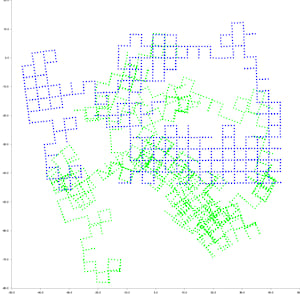7个不稳定版本 (3个破坏性更新)
| 0.6.0 | 2024年7月21日 |
|---|---|
| 0.5.0 | 2024年4月12日 |
| 0.4.1 | 2024年3月24日 |
| 0.3.4 | 2024年3月22日 |
#288 in 数学
每月138次下载
250KB
761 行
tiny-solver-rs
警告!此项目仍在开发中。
受ceres-solver、tiny-solver和minisam的启发。
这是一个用Rust编写的通用优化器,包括Python的绑定。如果您熟悉ceres-solver或因子图优化器,您会发现它非常容易使用。
安装
python
Python包可以直接从PyPI安装
pip install tiny-solver
rust
cargo add tiny-solver
当前功能
TODO
- LevenbergMarquardtOptimizer
- 信息矩阵
基准测试
| 数据集 | tiny-solver | gtsam | minisam |
|---|---|---|---|
| m3500 | 161.1ms | 130.7ms | 123.6 ms |
它不是特别优化,但安装和使用都很简单。
用法
Rust
// define your own Cost/Factor struct
// impl residual function
// and the jacobian will be auto generated
struct CustomFactor {}
impl tiny_solver::factors::Factor for CustomFactor {
fn residual_func(
&self,
params: &[nalgebra::DVector<num_dual::DualDVec64>],
) -> nalgebra::DVector<num_dual::DualDVec64> {
let x = ¶ms[0][0];
let y = ¶ms[1][0];
let z = ¶ms[1][1];
na::dvector![x + y.clone().mul(2.0) + z.clone().mul(4.0), y.mul(z)]
}
}
fn main() {
// init logger, `export RUST_LOG=trace` to see more log
env_logger::init();
// init problem (factor graph)
let mut problem = tiny_solver::Problem::new();
// add residual blocks (factors)
// add residual x needs to be close to 3.0
problem.add_residual_block(
1,
vec![("x".to_string(), 1)],
Box::new(tiny_solver::factors::PriorFactor {
v: na::dvector![3.0],
}),
None,
);
// add custom residual for x and yz
problem.add_residual_block(
2,
vec![("x".to_string(), 1), ("yz".to_string(), 2)],
Box::new(CustomFactor {}),
None,
);
// the initial values for x is 0.7 and yz is [-30.2, 123.4]
let initial_values = HashMap::<String, na::DVector<f64>>::from([
("x".to_string(), na::dvector![0.7]),
("yz".to_string(), na::dvector![-30.2, 123.4]),
]);
// initialize optimizer
let optimizer = tiny_solver::GaussNewtonOptimizer {};
// optimize
let result = optimizer.optimize(&problem, &initial_values, None);
// result
for (k, v) in result {
println!("{}: {}", k, v);
}
}
Python
import numpy as np
from tiny_solver import Problem, GaussNewtonOptimizer
from tiny_solver.factors import PriorFactor, PyFactor
# define custom cost function in python
# the trade off is the jacobian for the problem cannot be done in parallel
# because of gil
def cost(x: np.ndarray, yz: np.ndarray) -> np.ndarray:
r0 = x[0] + 2 * yz[0] + 4 * yz[1]
r1 = yz[0] * yz[0]
return np.array([r0, r1])
def main():
# initialize problem (factor graph)
problem = Problem()
# factor defined in python
custom_factor = PyFactor(cost)
problem.add_residual_block(
2,
[
("x", 1),
("yz", 2),
],
custom_factor,
None,
)
# prior factor import from rust
prior_factor = PriorFactor(np.array([3.0]))
problem.add_residual_block(1, [("x", 1)], prior_factor, None)
# initial values
init_values = {"x": np.array([0.7]), "yz": np.array([-30.2, 123.4])}
# optimizer
optimizer = GaussNewtonOptimizer()
result_values = optimizer.optimize(problem, init_values)
# result
for k, v in result_values.items():
print(f"{k}: {v}")
if __name__ == "__main__":
main()
示例
基本示例
cargo run -r --example small_problem
M3500数据集

git clone https://github.com/powei-lin/tiny-solver-rs.git
cd tiny-solver-rs
# run rust version
cargo run -r --example m3500_benchmar
# run python version
pip install tiny-solver matplotlib
python3 examples/python/m3500.py
依赖关系
~16–22MB
~381K SLoC